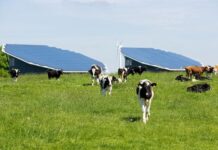by Louis Roesch, Director, OFA
Ontario is a large province, and its geography is as diverse as its people. That diversity is also evident when it comes to agriculture. Ontario’s farmers produce more than 200 different agricultural commodities, from milk, eggs and meat, to fruits, vegetables, flowers, crops for feed and fuel, and more.
My family and I farm in southwestern Ontario, and I also represent farmers from Essex and Chatham-Kent on the board of the Ontario Federation of Agriculture (OFA). We’re an advocacy organization that speaks on behalf of Ontario farmers, bringing agricultural and rural issues to the attention of policymakers.
I am joined at the board table by 17 fellow directors who come from all regions of the province, and we are each most knowledgeable about our own local areas. However, as directors, we collectively make decisions about the priorities and policies of our organization on local, provincial and federal issues.
That means we must also know about the issues, challenges and opportunities happening in other parts of Ontario, and although we can do that by reading, talking and listening, nothing beats the impact of a first-hand experience.
That’s why the OFA hosts a summer meeting and tour for its directors in a different region of the province every year – and this year, I’m pleased and proud to welcome my fellow board members to Southwestern Ontario for a tour of farms and agricultural businesses in our area.
There are many things that set our region apart, but one of the biggest is our climate. Because of our southern location, our growing season is about two months longer than that of our fellow farmers in Northern Ontario. We can start planting potatoes and sugar beets as early as March for example, if the soil is ready.
As well, we can grow a second field crop after green peas, winter canola or winter wheat once the first one is harvested, and the climate is warm and sunny enough that we can grow crops here that aren’t found in other parts of the province, like sugar beets.
We’re known for our field-processing vegetable production, from tomatoes, cucumbers and peas, to sweet corn, green beans and more. In fact, more than 90 per cent of processing tomatoes grown in Canada come from Chatham-Kent and Essex – that’s about 400,000 tons of tomatoes with a farm gate value estimated at $360 million.
We also produce most of Canada’s processing peas, green beans, sweet corn and pickling cucumbers, and we are the only region in the country that grows seed corn.
In addition to fresh vegetables like brussels sprouts and carrots, the Lake Erie shore is ideal for growing fruit like apples and peaches, and is the site of one of Ontario’s designated wine regions.
And of course, the Leamington area is home to one of North America’s largest greenhouse clusters, growing mainly peppers, tomatoes and cucumbers indoors, but also increasingly strawberries and other crops. More than 70 percent of that greenhouse vegetable production is exported, feeding people down the U.S. eastern seaboard and beyond.
The land in this part of Ontario is very flat and you’ll find a significant number of the province’s man-made drains, dikes, water pumping schemes and bridges down here.
This diversity of farming spells opportunity, and our proximity to the U.S. border means farmers in this area have both unique potential and unique challenges not all other regions share.
At the same time, getting to know other parts of the province lets us discover that we share some commonalities we didn’t know existed.
Last year, we visited Eastern Ontario, where farmers deal with railway crossing problems not unlike in my region, and also face decreasing availability of farm business services like veterinary care and meat processing.
The year before, we were hosted in the Niagara Region, home to most of our edible horticulture production, as well as the Welland Canal and a major exporting port in nearby Hamilton.
These are important issues and dynamics to know about and understand when you’re faced with making decisions that can impact the entire agriculture sector in the province.
The Essex Federation of Agriculture, the host of this year’s event, organized the very first tour for OFA board members and since then, it’s become an anticipated and interesting part of our annual event calendar.


